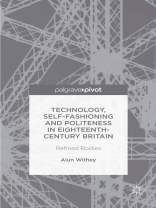The second half of the eighteenth century brought important changes in attitudes towards shaping the body. New expectations of polite conduct, deportment and demeanour were projected onto the body, with emphasis laid upon neatness, elegance and a ‘natural’ body shape. Deformities were to be concealed, whilst bodily surfaces were managed to convey a harmonious whole. A large number of ‘technologies of the body’ were involved in this process, including wooden legs, elastic trusses, and even wigs. But the introduction of a new type of steel – cast steel – around 1750, offered new material possibilities for shaping the body. The physical properties of steel transformed the design and function of many instruments, from postural devices to spectacles, and even the smallest daily items of toilette. By no means was steel the only material involved in transforming the body. Neither did it simply sweep away all that had gone before. But, as an ‘enlightened metal’, cast steel was a key material in the refinement of the body.

A. Withey: Technology, Self-Fashioning and Politeness in Eighteenth-Century Britain [PDF]
The second half of the eighteenth century brought important changes in attitudes towards shaping the body. New expectations of polite conduct, deportment and demeanour were projected onto the body, …




Reviews
There are no reviews yet.